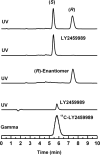An Improved Antagonist Radiotracer for the κ-Opioid Receptor: Synthesis and Characterization of (11)C-LY2459989
- PMID: 24854795
- PMCID: PMC4826283
- DOI: 10.2967/jnumed.114.138701
An Improved Antagonist Radiotracer for the κ-Opioid Receptor: Synthesis and Characterization of (11)C-LY2459989
Abstract
The κ-opioid receptors (KORs) are implicated in several neuropsychiatric diseases and addictive disorders. PET with radioligands provides a means to image the KOR in vivo and investigate its function in health and disease. The purpose of this study was to develop the selective KOR antagonist (11)C-LY2459989 as a PET radioligand and characterize its imaging performance in nonhuman primates.
Methods: LY2459989 was synthesized and assayed for in vitro binding to opioid receptors. Ex vivo studies in rodents were conducted to assess its potential as a tracer candidate. (11)C-LY2459989 was synthesized by reaction of its iodophenyl precursor with (11)C-cyanide, followed by partial hydrolysis of the resulting (11)C-cyanophenyl intermediate. Imaging experiments with (11)C-LY2459989 were performed in rhesus monkeys with arterial input function measurement. Imaging data were analyzed with kinetic models to derive in vivo binding parameters.
Results: LY2459989 is a full antagonist with high binding affinity and selectivity for KOR (0.18, 7.68, and 91.3 nM, respectively, for κ, μ, and δ receptors). Ex vivo studies in rats indicated LY2459989 as an appropriate tracer candidate with high specific binding signals and confirmed its KOR binding selectivity in vivo. (11)C-LY2459989 was synthesized in high radiochemical purity and good specific activity. In rhesus monkeys, (11)C-LY2459989 displayed a fast rate of peripheral metabolism. Similarly, (11)C-LY2459989 displayed fast uptake kinetics in the brain and an uptake pattern consistent with the distribution of KOR in primates. Pretreatment with naloxone (1 mg/kg, intravenously) resulted in a uniform distribution of radioactivity in the brain. Further, specific binding of (11)C-LY2459989 was dose-dependently reduced by the selective KOR antagonist LY2456302 and the unlabeled LY2459989. Regional binding potential values derived from the multilinear analysis-1 (MA1) method, as a measure of in vivo specific binding signal, were 2.18, 1.39, 1.08, 1.04, 1.03, 0.59, 0.51, and 0.50, respectively, for the globus pallidus, cingulate cortex, insula, caudate, putamen, frontal cortex, temporal cortex, and thalamus.
Conclusion: The novel PET radioligand (11)C-LY2459989 displayed favorable pharmacokinetic properties, a specific and KOR-selective binding profile, and high specific binding signals in vivo, thus making it a promising PET imaging agent for KOR.
Keywords: PET; antagonist; kappa opioid receptor; radioligand; synthesis and evaluation.
© 2014 by the Society of Nuclear Medicine and Molecular Imaging, Inc.
Figures







References
-
- Dhawan BN, Cesselin F, Raghubir R, et al. International Union of Pharmacology. XII. Classification of opioid receptors. Pharmacol Rev. 1996;48:567–592. - PubMed
-
- Minami M, Satoh M. Molecular biology of the opioid receptors: structures, functions and distributions. Neurosci Res. 1995;23:121–145. - PubMed
-
- Hiller JM, Fan LQ. Laminar distribution of the multiple opioid receptors in the human cerebral cortex. Neurochem Res. 1996;21:1333–1345. - PubMed
-
- Mathieu-Kia AM, Fan LQ, Kreek MJ, Simon EJ, Hiller JM. μ-, δ- and κ-opioid receptor populations are differentially altered in distinct areas of postmortem brains of Alzheimer’s disease patients. Brain Res. 2001;893:121–134. - PubMed
-
- Peckys D, Landwehrmeyer GB. Expression of mu, kappa, and delta opioid receptor messenger RNA in the human CNS: a 33P in situ hybridization study. Neuroscience. 1999;88:1093–1135. - PubMed
Publication types
MeSH terms
Substances
Grants and funding
LinkOut - more resources
Full Text Sources
Other Literature Sources
Medical
Research Materials
